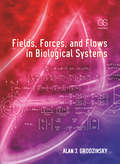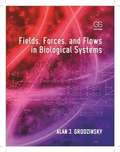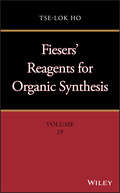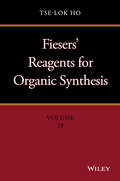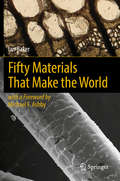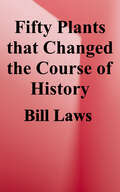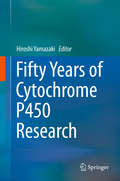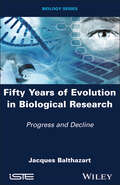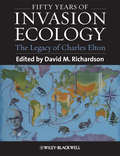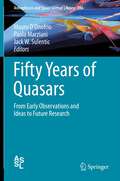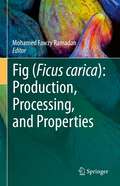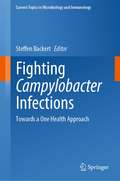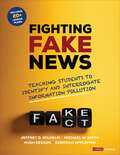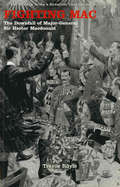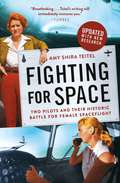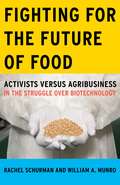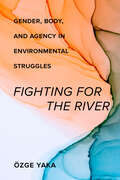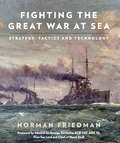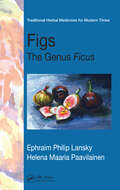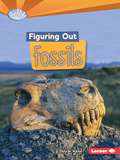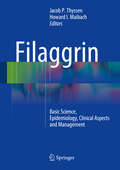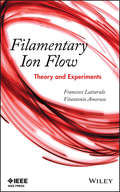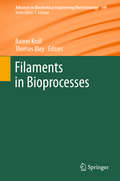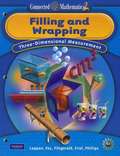- Table View
- List View
Fields, Forces, and Flows in Biological Systems
by Alan J GrodzinskyFields, Forces, and Flows in Biological Systems describes the fundamental driving forces for mass transport, electric current, and fluid flow as they apply to the biology and biophysics of molecules, cells, tissues, and organs. Basic mathematical and engineering tools are presented in the context of biology and physiology.The chapters are structured in a framework that moves across length scales from molecules to membranes to tissues. Examples throughout the text deal with applications involving specific biological tissues, cells, and macromolecules. In addition, a variety of applications focus on sensors, actuators, diagnostics, and microphysical measurement devices (e.g., bioMEMs/NEMs microfluidic devices) in which transport and electrokinetic interactions are critical.This textbook is written for advanced undergraduate and graduate students in biological and biomedical engineering and will be a valuable resource for interdisciplinary researchers including biophysicists, physical chemists, materials scientists, and chemical, electrical, and mechanical engineers seeking a common language on the subject.
Fields, Forces, and Flows in Biological Systems
by Alan J. GrodzinskyDescribes the fundamental driving forces for mass transport, electric current, and fluid flow as they apply to the biology and biophysics of molecules, cells, tissues, and organs. This textbook presents basic mathematical and engineering tools in the context of biology and physiology.
Fiesers' Reagents for Organic Synthesis (Fiesers' Reagents for Organic Synthesis #28)
by Tse-Lok HoFiesers' Reagents for Organic Synthesis provides an up-to-date, A-to-Z listing of reagents cited in synthetic literature.• Covers, in volume 29, chemical literature and methodologies from 2013-mid 2014• Features entries with concise descriptions, illustrations of chemical reactions, selected examples of applications• Includes author indexes and subject indexes• Offers practical information on reagents’ usefulness, where to find complete details
Fiesers' Reagents for Organic Synthesis, Volume 28
by Tse-Lok HoFiesers' Reagents for Organic Synthesis provides an up-to-date, A-to-Z listing of reagents cited in synthetic literature. * Covers, in volume 28, chemical literature and methodologies from July 2011 - December 2012* Features entries with concise descriptions, illustrations of chemical reactions, selected examples of applications* Includes author indexes and subject indexes* Offers practical information on making/buying reagent, its usefulness, where to find complete details
Fifty Materials That Make the World
by Ian BakerThis book introduces materials and how advances in materials result in advances in technology and our daily lives. Each chapter covers a particular material, how the material was discovered or invented, when it was first used, how this material has impacted the world, what makes the material important, how it is used today, and future applications. The list of materials covered in this book includes stone, wood, natural fibers, metals, clay, lead, iron, steel, silicon, glass, rubber, composites, polyethylene, rare earth magnet, and alloys.
Fifty Plants That Changed the Course of History
by Bill LawsOf course, we are entirely dependent on plants for our food and the air we breathe, but did you know that 5,000 mature English oak trees were used in the construction of Admiral Nelson’s flagship HMS Victory, or that sweet peas were involved in the birth of the science of genetics? King Cotton was the driver of the slave trade, which was the first domino to fall in the American Revolution, and cotton was also the catalyst for the Industrial Revolution. <p><p>These, and many other extraordinary facts in Fifty Plants that Changed the Course of History, highlight the dynamic ways in which plants have influenced human history. This beautifully designed and illustrated volume provides an engaging guide to the fifty key plants that have had the most impact on human history. Packed full of information, the book includes details about the habitat and characteristics of each plant, fact boxes, full colour photographs and lovely botanical illustrations. Weaving together strands of economic, political and agricultural history, each entry is a fascinating look at the most influential plants known to mankind.
Fifty Years of Cytochrome P450 Research
by Hiroshi YamazakiThis book encompasses major progress and future directions in cytochrome P450 (P450) research. Included are contributions by pioneers in the discovery of P450, with chapters on the molecular and functional properties of P450 and cutting-edge applications knowledge from various fields. P450 research has its roots in metabolism, but the true beginning was in 1962 with the publication by Tsuneo Omura and Ryo Sato in The Journal of Biological Chemistry on their discovery of the cytochrome. Following this groundbreaking study, over the last half-century, research has revealed that many forms of P450 exist in animals, plants and microorganisms. P450 research has expanded into many different fields including medicine, agriculture and biotechnology and has drawn the attention of industries for its bioengineering applications, such as drug development and creation of the "blue rose". Also, research on nuclear receptors, which has grown out of research on the regulatory mechanisms of P450 genes, has become an important area in biology, medical science, pharmacology and clinical medicine--for example, with recent developments in personalized medicines. This book will draw readers into the important and exciting world of P450 and will encourage young students and scientists in P450 research to continue expanding the field via new approaches.
Fifty Years of Evolution in Biological Research: Progress and Decline
by Jacques BalthazartResearch in biology and all basic sciences has undergone profound transformations in recent decades. We have seen the development of extremely sophisticated techniques, allowing us to study, in an objective manner, questions that were still considered science fiction at the end of the 20th century. All of this has allowed us to develop an in-depth knowledge of vast subjects, such as the biology of the brain, for example. Fifty Years of Evolution in Biological Research presents a panorama of these different technical advances. However, at the same time, there has been an increase in the number of constraints on researchers, a monetization of research and a correlative pressure to continually publish in more prestigious journals. This has resulted in a certain degradation of the quality of research activity. This book analyzes this evolution and proposes solutions.
Fifty Years of Invasion Ecology: The Legacy of Charles Elton
by David M. RichardsonInvasion ecology is the study of the causes and consequences of the introduction of organisms to areas outside their native range. Interest in this field has exploded in the past few decades. Explaining why and how organisms are moved around the world, how and why some become established and invade, and how best to manage invasive species in the face of global change are all crucial issues that interest biogeographers, ecologists and environmental managers in all parts of the world. This book brings together the insights of more than 50 authors to examine the origins, foundations, current dimensions and potential trajectories of invasion ecology. It revisits key tenets of the foundations of invasion ecology, including contributions of pioneering naturalists of the 19th century, including Charles Darwin and British ecologist Charles Elton, whose 1958 monograph on invasive species is widely acknowledged as having focussed scientific attention on biological invasions.
Fifty Years of Quasars
by Mauro D'Onofrio Paola Marziani Jack W. SulenticThe 50th anniversary of the discovery of quasars in 1963 presents an interesting opportunity to ask questions about the current state of quasar research. Formatted as a series of interviews with noted researchers in the field, each of them asked to address a specific set of questions covering topics selected by the editors, this book deals with the historical development of quasar research and discusses how advances in instrumentation and computational capabilities have benefitted quasar astronomy and have changed our basic understanding of quasars. In the last part of the book the interviews address the current topic of the role of quasars in galaxy evolution. They summarise open issues in understanding active galactic nuclei and quasars and present an outlook regarding what future observational facilities both on the ground and in space might reveal. Its interview format, the fascinating topic of quasars and black holes, and the lively recollections and at times controversial views of the contributors make this book both rewarding and a pleasure to read!
Fig (Food Bioactive Ingredients Ser.)
by Mohamed Fawzy RamadanThis book creates a multidisciplinary forum of discussion on Ficus carica with particular emphasis on its horticulture, post-harvest, marketability, phytochemistry, extraction protocols, biochemistry, nutritional value, functionality, health-promoting properties, ethnomedicinal applications, technology and processing. The impact of traditional and innovative processing on the recovery of high-added value compounds from Ficus carica byproducts is extensively reported. Also, the text discusses the potential applications of Ficus carica in food, cosmetics, and pharmaceutical products. Fig (Ficus carica): Production, Processing, and Properties illustrates a diversity of developments in food science and horticultural research including:Production, processing, chemistry, and functional properties of Ficus carica.Ficus carica phytochemicals and its health-promoting effects.Food, non-food and technological applications of Ficus carica.Recent research focuses on studying the bioactive compounds and therapeutic traits and investigating the mode of action and toxicological impacts of medical plant extracts and bioactive phytochemicals. Ficus carica is of significant importance due to its widespread food, industrial and medicinal applications. Although Ficus carica products are already commercially available in the international market, it is hard to find a reference work covering the production, processing, chemistry and properties of Ficus carica. This book will be the first publication focusing specifically on this important topic.
Fighting Campylobacter Infections: Towards a One Health Approach (Current Topics in Microbiology and Immunology #431)
by Steffen BackertThis edited volume explores Campylobacter species, which are some of the most important foodborne pathogens. Above all, contaminated poultry meat can cause human gastroenteritis in both developed and developing countries. The respective contributions reveal how these infections can also increase the risk of generalized paralytic diseases such as Guillain-Barré syndrome, Miller-Fisher syndrome, and Chinese paralytic syndrome. Due to their influence on the nervous system, circulatory system, and various organs, Campylobacter infections represent a serious public health concern.Campylobacter can be effectively combated by addressing the hygienic conditions in both food production and human lifestyles. Accordingly, the authors put forward a One Health perspective, which provides readers with essential insights into the basic biology of Campylobacter, as well as practical guidance on aspects ranging from food production to the clinical treatment of infections.Chapter 'Natural Competence and Horizontal Gene Transfer in Campylobacter’ is available open access under a Creative Commons Attribution 4.0 International License via link.springer.com.
Fighting Fake News: Teaching Students to Identify and Interrogate Information Pollution (Corwin Literacy)
by Michael W. Smith Jeffrey D. Wilhelm Deborah Appleman Hugh KessonCritical thinking and online reading need to go hand in hand—but they often don’t. Students click, swipe, and believe because they don’t know how to do otherwise. At times, so do we. And that’s a problem. Fighting Fake News combats this challenge by helping you model how to read, myth-bust, truth-test, and respond in ways that lead to wisdom rather than reactivity. No matter what content you teach, the lessons showcased here provide engaging, collaborative reading and discussion experiences so students can: Notice how teacher and peers read digital content, to be mindful of how various reading pathways influence perception Identify the author background, the website sponsor, and other evidence that help set a piece in context Stress-test the facts by evaluating news sources, reading laterally, and other critical reading strategies Use "Reader’s Rules of Notice" to learn to identify common rhetorical devices used to influence the reader Be aware of how for-profit social media platforms feed on our responses to narrow rather than widen our reading landscape We are still in the wild west era of the digital age, scrambling to impart a safer, ethical framework for evaluating information. Thankfully, it distills to one mission: teach students (and ourselves) how to think critically, and we will forever have the tools to fight fake news.
Fighting Fake News: Teaching Students to Identify and Interrogate Information Pollution (Corwin Literacy)
by Michael W. Smith Jeffrey D. Wilhelm Deborah Appleman Hugh KessonCritical thinking and online reading need to go hand in hand—but they often don’t. Students click, swipe, and believe because they don’t know how to do otherwise. At times, so do we. And that’s a problem. Fighting Fake News combats this challenge by helping you model how to read, myth-bust, truth-test, and respond in ways that lead to wisdom rather than reactivity. No matter what content you teach, the lessons showcased here provide engaging, collaborative reading and discussion experiences so students can: Notice how teacher and peers read digital content, to be mindful of how various reading pathways influence perception Identify the author background, the website sponsor, and other evidence that help set a piece in context Stress-test the facts by evaluating news sources, reading laterally, and other critical reading strategies Use "Reader’s Rules of Notice" to learn to identify common rhetorical devices used to influence the reader Be aware of how for-profit social media platforms feed on our responses to narrow rather than widen our reading landscape We are still in the wild west era of the digital age, scrambling to impart a safer, ethical framework for evaluating information. Thankfully, it distills to one mission: teach students (and ourselves) how to think critically, and we will forever have the tools to fight fake news.
Fighting Mac: The Downfall of Major-General Sir Hector Macdonald
by Trevor RoyleOn a spring morning in 1903, Major-General Sir Hector Macdonald, one of Britain's greatest military heroes, took his life in a hotel room in Paris. A few days later he was buried hastily in an Edinburgh cemetary as his fellow countrymen tried to come to terms with the fact that one of Scotland's most famous soldiers had ended his life rather than face charges against his character.The suicide and its aftermath created a national scandal and one which still reverberates long after those dramatic events - it is now clear that the official files dealing with his case, the papers of the Judge Advocate have been destroyed. Macdonald or 'Fighting Mac' as he was known to an adoring public, was no ordinary soldier. A crofter's son who had risen from the ranks in the Victorian army, he covered himself with glory during a long and successful military career and in 1898 was widely acknowledged as the true hero of the Battle of Omdurman, which cemented British Imperial rule in Anglo-Egyptian Sudan. Everything lay at his feet - a knighthood, honours, the respect of fellow generals such as Roberts and Kitchener - but Macdonald's career came to a shocking full stop when he stood accused of homosexuality and was ordered to face a court martial. Unable to come to terms with the disgrace, he committed suicide. That should have been the end of his story but so powerful was the myth created by Fighting Mac that people refused to believe he was dead. Soon rumours were circulating that Macdonald had faked his death and had adopted the persona of a prominent Prussian officer, the future Field Marshal August con Mackensen, one of Germany's great leaders during the First World War. FIGHTING MAC tells the true story behind his disgrace and sheds new light on the myths....
Fighting for Space: Two Pilots and Their Historic Battle for Female Spaceflight
by Amy TeitelSpaceflight historian Amy Shira Teitel tells the riveting story of the female pilots who each dreamed of being the first American woman in space. When the space age dawned in the late 1950s, Jackie Cochran held more propeller and jet flying records than any pilot of the twentieth century-man or woman. She had led the Women's Auxiliary Service Pilots during the Second World War, was the first woman to break the sound barrier, ran her own luxury cosmetics company, and counted multiple presidents among her personal friends. She was more qualified than any woman in the world to make the leap from atmosphere to orbit. Yet it was Jerrie Cobb, twenty-five years Jackie's junior and a record-holding pilot in her own right, who finagled her way into taking the same medical tests as the Mercury astronauts. The prospect of flying in space quickly became her obsession. While the American and international media spun the shocking story of a "woman astronaut" program, Jackie and Jerrie struggled to gain control of the narrative, each hoping to turn the rumored program into their own ideal reality-an issue that ultimately went all the way to Congress. This dual biography of audacious trailblazers Jackie Cochran and Jerrie Cobb presents these fascinating and fearless women in all their glory and grit, using their stories as guides through the shifting social, political, and technical landscape of the time.
Fighting for the Future of Food: Activists versus Agribusiness in the Struggle over Biotechnology (Social Movements, Protest and Contention #35)
by William A. Munro Rachel SchurmanWhen scientists working in the agricultural biotechnology industry first altered the genetic material of one organism by introducing genes from an entirely different organism, the reaction was generally enthusiastic. To many, these genetically modified organisms (GMOs) promised to solve the challenges faced by farmers and to relieve world hunger. Yet within a decade, this &“gene revolution&” had abruptly stalled. Widespread protests against the potential dangers of &“Frankenfoods&” and the patenting of seed supplies in the developing world forced the industry to change course. As a result, in the late 1990s, some of the world&’s largest firms reduced their investment in the agricultural sector, narrowed their focus to a few select crops, or sold off their agricultural divisions altogether.Fighting for the Future of Food tells the story of how a small group of social activists, working together across tables, continents, and the Internet, took on the biotech industry and achieved stunning success. Rachel Schurman and William A. Munro detail how the anti-biotech movement managed to alter public perceptions about GMOs and close markets to such products. Drawing strength from an alternative worldview that sustained its members&’ sense of urgency and commitment, the anti-GMO movement exploited political opportunities created by the organization and culture of the biotechnology industry itself. Fighting for the Future of Food ultimately addresses society&’s understanding and trust (or mistrust) of technological innovation and the complexities of the global agricultural system that provides our food.
Fighting for the River: Gender, Body, and Agency in Environmental Struggles
by Özge YakaFighting for the River portrays women's intimate, embodied relationships with river waters and explores how those relationships embolden local communities' resistance to private run-of-the-river hydroelectric power plants in Turkey. Building on extensive ethnographic research, Özge Yaka develops a body-centered, phenomenological approach to women's environmental activism and combines it with a relational ontological perspective. In this way, the book pushes beyond the "natural resources" frame to demonstrate how our corporeal connection to nonhuman entities is constitutive of our more-than-human lifeworld. Fighting for the River takes the human body as a starting point to explore the connection between lived experience and nonhuman environments, treating bodily senses and affects as the media of more-than-human connectivity and political agency. Analyzing local environmental struggles as struggles for coexistence, Yaka frames human-nonhuman relationality as a matter of socio-ecological justice.
Fighting the Great War at Sea: Strategy, Tactic and Technology
by Norman FriedmanWinner of the John Lyman Book Award for Naval and Maritime Science and Technology. &“A compelling and convincing historical analysis of World War I.&” —Navy News While the overriding image of the First World War is of the bloody stalemate on the western front, the overall shape of the war arose out of its maritime character. It was essentially a struggle about access to worldwide resources, most clearly seen in Germany&’s desperate attempts to counter the American industrial threat, which ultimately drew the United States into the war. This radical new book concentrates on the way in which each side tried to use or deny the sea to the other, and in so doing, describes rapid wartime changes not only in ship and weapons technology but also in the way naval warfare was envisaged and fought. Melding strategic, technical, and tactical aspects, Friedman approaches the First World War from a fresh perspective and demonstrates how its perceived lessons dominated the way navies prepared for the Second World War. &“Friedman is a master of the evolution of naval strategy, tactics and technology . . . a rewarding read that will leave many wanting to return again and again just to see what they might have missed the first time.&” —Australian Naval Institute &“Dr. Friedman&’s research credentials are impeccable, and the huge amount of factual detail he has unearthed will be sure to delight many . . . there is nothing comparable in either depth or scope out there, and for this reason, if no other, this book is likely to become a standard work on the naval aspects of the Great War.&” —Naval War College Review
Figs: The Genus Ficus (Traditional Herbal Medicines for Modern Times)
by Helena Maaria Paavilainen Ephraim Philip LanskyWith a history as ancient as any cultivated fruit, many believe the fig has been with us even longer than the pomegranate. The Ficus constitutes one of the largest and hardiest genera of flowering plants featuring as many as 750 species. Although the extraordinary mutualism between figs and their pollinating wasps has received much attention, the p
Figuring Out Fossils (Searchlight Books - Do You Dig Earth Science?)
by Sally M. WalkerFossils give us a window to the past. Water, sediments, and pressure work together over time to preserve the shape of things that lived long ago. Studying these ancient plants and animals tells us more about our own existence. Have you ever searched for fossils? Unearth some in this book.
Filaggrin
by Howard I. Maibach Jacob P. ThyssenFilaggrin gene mutations are common in Europeans and their descendants, as well as in Asians, reaching a prevalence of up to 10%. Filaggrin proteins are crucial for skin homeostasis as their metabolites maintain skin hydration, keep the skin pH low, and provide protection against solar radiation. FLG mutation carriers suffer from dry and scaly skin and have an increased transfer of allergens and chemicals across the epidermis. Moreover, they have 10% higher serum vitamin D levels, potentially affecting the propensity to develop other diseases. FLG loss-of-function mutations represent the strongest risk factor hitherto discovered for atopic dermatitis and are major predisposing factors for related asthma and hay fever. This textbook provides comprehensive and detailed coverage of the effects of FLG mutations in health and disease (cutaneous and non-cutaneous) and also discusses the basic science, epidemiology, management, and future research areas.
Filamentary Ion Flow: Theory and Experiments
by Vitantonio Amoruso Francesco LattaruloPresents all-new laboratory-tested theory for calculating more accurate ionized electric fields to aid in designing high-voltage devices and its components Understanding and accurately calculating corona originated electric fields are important issues for scientists who are involved in electromagnetic and electrostatic studies. High-voltage dc lines and equipment, in particular, can generate ion flows that can give rise to environmental inconveniences. Filamentary Ion Flow: Theory and Experiments provides interdisciplinary theoretical arguments to attain a final model for computational electrostatics in the presence of flowing space charge. Based on years of extensive lab tests pertaining to the physical performance of unipolar corona ion flows, the book covers the enlarging of conventional electrostatic applications, which allows for some emerging and uncharted interests to be explored. Filamentary Ion Flow: Examines the theoretical discussions for creating a model of computational electrostatics involved with flowing space charges Presents new theory and experimental data based on extensive testing Offers potential design applications utilizing the theory Helps scientists who are involved in electromagnetic and electrostatic studies understand and accurately calculate corona originated ion flow fields Filamentary Ion Flow: Theory and Experiments is ideal for electrical engineers and research scientists interested in high-voltage technology, computational electrostatics, and electromagnetic theory.
Filaments in Bioprocesses
by Rainer Krull Thomas BleyThis book review series presents current trends in modern biotechnology. The aim is to cover all aspects of this interdisciplinary technology where knowledge, methods and expertise are required from chemistry, biochemistry, microbiology, genetics, chemical engineering and computer science. Volumes are organized topically and provide a comprehensive discussion of developments in the respective field over the past 3-5 years. The series also discusses new discoveries and applications. Special volumes are dedicated to selected topics which focus on new biotechnological products and new processes for their synthesis and purification. In general, special volumes are edited by well-known guest editors. The series editor and publisher will however always be pleased to receive suggestions and supplementary information. Manuscripts are accepted in English.
